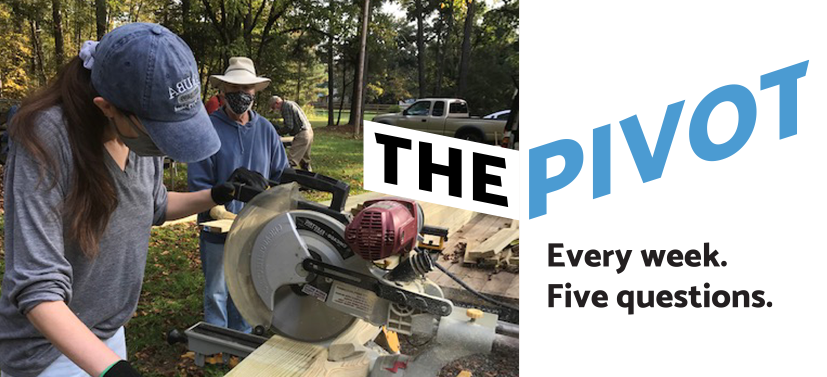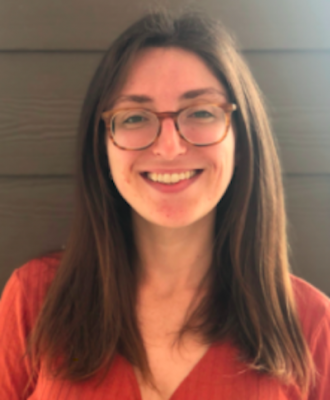
Morgan Cooper helps older adults stay safe at home.

What’s your role in public health?
I’m in my third year of a Master of Public Health and Master of City and Regional Planning dual degree program. I also intern with UNC’s Partnerships in Aging Program, which gives me a chance to work with the Orange County Department on Aging (OCDOA) Handy Helper Program.

Can you describe your focus area in one sentence?
I promote older adult home safety, accessibility and preservation.
Using more words, that means helping older adults maintain a safe environment in their homes so they can reduce accidents, avoid living out their days in an institutional setting and keep their house in good condition so it generates wealth. I do this by coordinating OCDOA’s Handy Helper program, which is a volunteer-based minor home repair program.
Part of my work also supports Orange County’s Home Preservation Coalition, which recently created a common application that allows a homeowner to apply once and reach all the different home repair groups in the county. We send an assessor through Rebuilding Together of the Triangle to do a comprehensive home assessment, and then member organizations divvy up projects based on their technical specialties and funding flexibility. Homeowners previously had to reach out to each group separately, but our new system offers a clearer path forward.

What brought you to public health?
I studied nutrition as an undergraduate and spent a year getting the credentials to be a Registered Dietitian. I worked for a while as a community nutrition educator, but I got disillusioned with models of behavior change that rely on education. I was hyper aware of the systematic barriers keeping participants from making the changes I was encouraging them to try. They had so many really good reasons why they weren’t able to shift their behavior — I couldn’t blame them, and I wanted to do more.
Once I really understood that our health behaviors aren’t just our personal responsibility but also are linked to the institutional and environmental contexts in which we live, I decided to pursue a route that would set me up to shape those broader contexts. Instead of counseling someone to eat fast food less often, maybe I could advocate for a local government ordinance to regulate the distance between fast food restaurants and schools.
Honestly, I keep browsing Indeed.com and feeling this yearning for a certain kind of job — roles I wasn’t qualified for yet, but that offered the opportunity to create lasting change on a larger scale. I applied for this dual degree knowing it would give me the skills I’d need.
Combining the fields of planning and public health has been a real asset in my work at OCDOA. In 2020, my supervisor, Dr. Ryan Lavalley, and I completed the first-ever program evaluation of Handy Helpers. Each degree program influenced the questions we asked and the tools we used to get answers. From the public health perspective, we developed a survey to understand how our program was changing the lives of individual service recipients — how did homeowners experience their quality of life change after their home repair/modification? The planner in me wanted to explore community impact — how are our services distributed geographically across the county? Are we investing most in the areas with older and lower-income populations?
Using mapping tools and comparisons to census data, we became confident that Handy Helpers is reaching who it intends to. Underlying all of this was Ryan’s attention to occupation, safety, and quality of life. For my public health practicum, I’m conducted a similar evaluation for the Home Preservation Coalition (PDF); again, using approaches from both fields of practice yielded a rich sense of our impact.
I feel like the link between home and health is coming to the forefront of public attention right now. The connection boils down to a few key pillars:
1. Housing needs to be affordable so residents can maintain enough of their income to pay for medicine, food and other health-related costs.
2. Housing needs to be safe and high-quality, meaning there are no hazards like asbestos, which could lead to an ongoing health condition, or a broken floor board, which could lead to an accident. A home also needs to be comfortable; extreme indoor temperatures can be dangerous — especially for older adults — and are, frankly, unpleasant.
3. Housing needs to be stable. We can’t overlook the positive health effects of having a home that is a reliable, stress-free respite from the world. With a stable, safe home, people can age in place if they choose (and most do prefer this option).
4. Housing needs to be embedded within a community, so residents have help and resources. Taking the idea of “aging in place” one step forward, “aging in community” means that older adults have access to key services and are surrounded by neighbors who offer comfort, familiarity and support.

How have you pivoted in response to the coronavirus pandemic?
Like everyone else, we’ve moved our meetings to Zoom. Once a month, the partners at the Home Preservation Coalition still come together to discuss shared case management, and the Handy Helper volunteers are starting to meet again — virtually — to discuss new projects.
We had to take a long pause at the start of the pandemic, because our work requires going into the homes of older people, and we didn’t want to put them or our volunteers at risk. We built up a big backlog of repair requests, which felt especially unfortunate at a time when everyone was being told it’s safer to stay home, but we couldn’t get into people’s homes to make sure they felt healthy and comfortable there.
Now, Handy Helpers volunteers are doing exterior projects again, like building ramps for outdoor staircases and putting up deck railings, utilizing federal funds available due to the pandemic. We also have a new partnership between the OCDOA, Orange County Housing and Community Development, and an organization called Hope Renovations to fund and complete our most common interior repairs safely — things like installing grab bars in bathrooms. Partners in the Home Preservation Coalition are also moving forward in different ways, with some organizations sticking to exterior repairs and others resuming significant interior projects. As we move forward, our goal is to continue supporting older adults in every way we can safely manage.

Who are you when you’re at home?

I’m actually a Registered Dietitian, so it’s no surprise that I love baking and cooking. I also love walking — I’m from New York, and my mom taught me two things from a very young age: Walk whenever you can and walk quickly.
Here’s another fun transportation fact: I didn’t learn how to ride a bike until I was 23. I give all the credit for this to my best friend. I went to visit her, and she said, “I know you want to learn this. We have the time; I have an extra bike; let’s do it.” Four days later, I could ride a bike!
